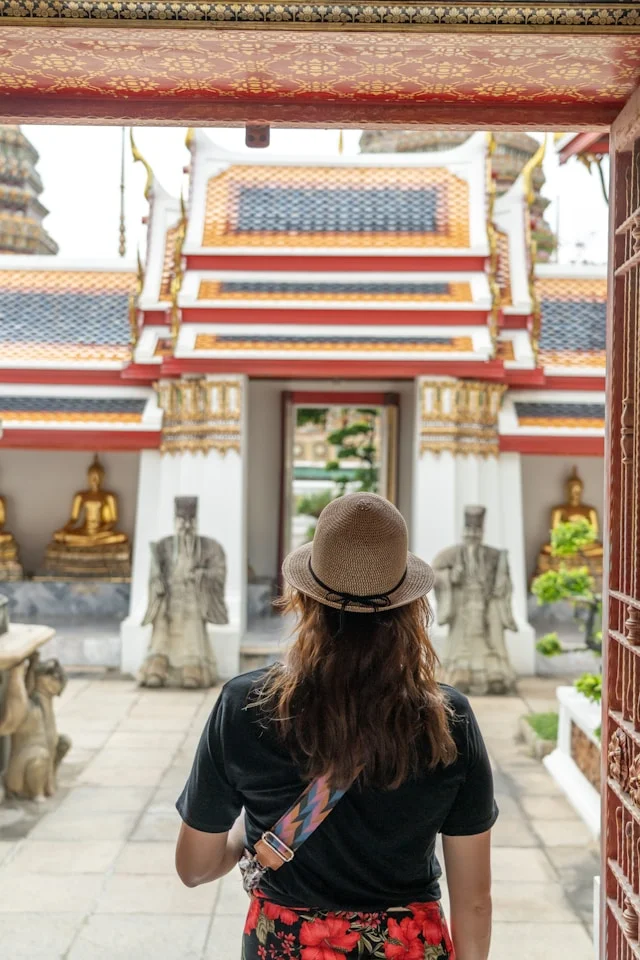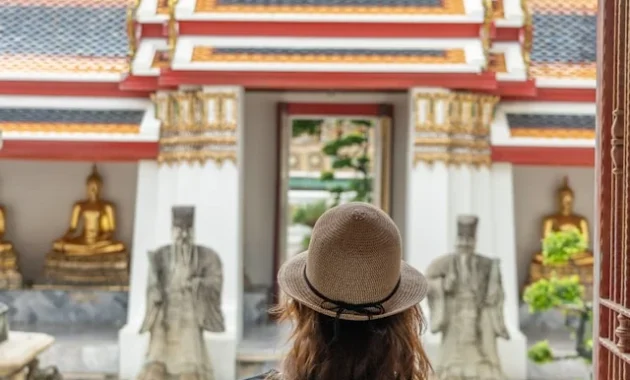
A Brief History of Wat Pho Chai
Wat Pho Chai holds a deep historical significance that dates back to the 19th century. It is believed that the temple was constructed during the reign of King Rama III, making it a historical landmark that has witnessed centuries of religious devotion and cultural change. What distinguishes Wat Pho Chai from other temples in Thailand is the temple’s most prized possession: the Luang Pho Phra Sai, a sacred golden Buddha statue with a fascinating history.
The Luang Pho Phra Sai was originally part of a set of three Buddha images created by the Laotian royal family in Vientiane. These statues were created to symbolize unity and protection. However, during a turbulent period in history, the statues were separated and brought to Thailand. The Luang Pho Phra Sai found its permanent home in Wat Pho Chai, where it has been venerated for centuries as a symbol of peace and resilience. The statue’s delicate craftsmanship and serene expression have drawn thousands of devotees, making it one of the most revered objects of worship in Thailand.
Architectural Splendor: A Feast for the Eyes
As one approaches Wat Pho Chai, the intricate design and awe-inspiring architecture captivate the senses. The temple complex is a harmonious blend of traditional Lao and Thai architectural styles, making it a visually stunning representation of regional aesthetics.
The main ordination hall, or ubosot, is adorned with vibrant murals depicting the life of the Buddha and other religious scenes. These murals offer a vivid glimpse into Buddhist philosophy, inviting visitors to contemplate and reflect upon their teachings. The hall itself is an impressive structure with a multi-tiered roof, glittering gold accents, and intricately carved wooden details. The craftsmanship of the artisans who contributed to the temple’s construction speaks to the enduring legacy of Thai and Lao art.
In addition to the main hall, visitors can explore the chedis (stupas) that dot the temple grounds. These chedis house sacred relics and provide spaces for quiet meditation. The peaceful atmosphere that permeates the grounds of Wat Pho Chai makes it an ideal location for those seeking spiritual refuge and a deeper connection with Buddhist teachings.
The Religious Importance of Wat Pho Chai

Wat Pho Chai is more than just an architectural marvel; it is a living, breathing center of Buddhist worship and community life in Nong Khai. The temple is home to numerous monks who follow the Theravada tradition, practicing meditation, and leading daily religious ceremonies. Visitors to the temple can participate in these rituals, offering food to the monks in the early morning as part of the merit-making process.
The temple also plays a central role during Songkran, the Thai New Year festival, when the Luang Pho Phra Saistatue is paraded through the streets of Nong Khai. This annual event attracts thousands of locals and tourists alike, who come to witness and participate in the joyous celebrations. The procession is a vibrant display of Thai culture, with participants splashing water and paying respects to the sacred image, a practice believed to bring good fortune for the year ahead.
Cultural Significance: A Community Anchor
Wat Pho Chai stands as a beacon of cultural unity and religious significance in Nong Khai. It is a symbol of the province’s deep-rooted connection to both Lao and Thai heritage, reflecting the harmonious blending of the two cultures over centuries. Many local families have a longstanding relationship with the temple, making it an integral part of community life. Weddings, funerals, and other important life events are often held within its sacred grounds, further solidifying its role as a center of social cohesion.
Furthermore, the temple provides educational opportunities for young monks and laypeople. Buddhist teachings are imparted through formal classes, and the temple acts as a sanctuary for those seeking to deepen their understanding of Buddhist philosophy. In this way, Wat Pho Chai continues to serve as a spiritual and educational hub for the people of Nong Khai and beyond.
What to Expect When Visiting Wat Pho Chai
When visiting Wat Pho Chai, one can expect an immersive experience filled with both spiritual reflection and cultural exploration. The temple grounds are open to the public daily, and visitors are encouraged to dress modestly, as is customary when visiting religious sites in Thailand. Shoes must be removed before entering the temple buildings, and it is respectful to remain quiet while inside, as worshippers may be engaged in prayer or meditation.
For those interested in Buddhist rituals, observing or participating in the monk’s daily alms-giving process can provide a unique insight into local religious practices. Visitors should also take the time to admire the Luang Pho Phra Sai, either during a religious ceremony or on display inside the ordination hall. Its golden glow and peaceful demeanor are sure to leave a lasting impression on anyone fortunate enough to witness it.
Photography is allowed in most areas of the temple, but it is important to be respectful and avoid disturbing those in prayer. As the temple is a functioning religious site, visitors are encouraged to engage with the local culture thoughtfully and respectfully.
How to Get to Wat Pho Chai
Wat Pho Chai is located in the heart of Nong Khai, a short distance from the Mekong River. The city itself is easily accessible by train, bus, or private car from Bangkok, with the journey taking approximately 9 to 10 hours by road or overnight by train. For those arriving from Laos, Nong Khai is just a short drive from the Thai-Lao Friendship Bridge, which connects the city to Vientiane.
Upon arrival in Nong Khai, the temple is only a few kilometers from the main city center, making it easy to visit by tuk-tuk, bicycle, or even on foot. The surrounding area is full of charming local markets and restaurants where visitors can experience authentic Isaan cuisine, adding another layer to the cultural experience.
Conclusion
A visit to Wat Pho Chai is a journey into the heart of Nong Khai’s cultural and spiritual identity. Whether you are drawn by the stunning architecture, the rich historical significance of the Luang Pho Phra Sai, or the tranquil atmosphere of Buddhist worship, this temple offers something for everyone. It stands as a testament to the enduring power of faith, art, and community in Thailand.